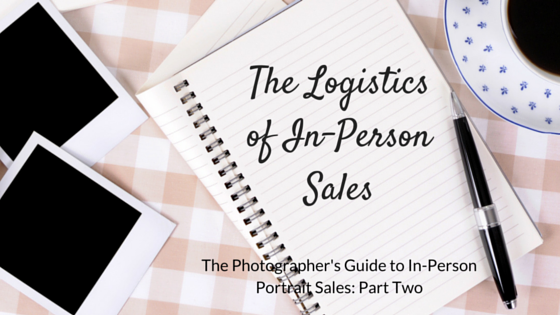
In our last blog post, we outlined 5 Reasons Photographers Should Do In-Person Portrait Sales. Now that you know you should consider IPS, we are ready to walk you through the logistics of getting started or improving upon your existing in-person sales strategy.
Preparing Your Clients
One of the most important things you should do to ensure the success of your in-person portrait sales—and we cannot stress this enough—is to be sure your clients know that you are meeting for an ordering session. You do not want clients to arrive expecting to view their images but unaware that they should be ordering as well.
One way that you can nicely convey this expectation is with a pre-drafted email you can send to each of your clients when their ordering session is scheduled. Using an email template (such as those available through StickyEmail), you can provide basic details as to what they can expect. After a few minutes of composing, you can have a professional (but generic) email that can quickly be sent to anyone scheduling a proofing session with you.
We would recommend you include your pricing structure in this email as well—while they should have been informed of your pricing prior to any portrait sessions, this will serve as a reminder before they arrive to place their order.
Picking a Location
If you are a portrait photographer with a studio location, the choice of location for an ordering session may be obvious for you. If you do not have studio space, never fear!—the location is not the make-or-break factor in your ordering session. You may consider using your home, your client’s home, or a neutral location such as a coffee shop for your in-person sales session.
Whatever location you choose should allow for a bit of privacy and have minimal noise disruption. Aside from this, you can adapt to your environment and have a successful session from anywhere! The key is to make your client feel comfortable and able to spend time looking over their images and discussing their needs with you.
One advantage of having the ordering session in a client’s home is that they can show you specific spaces they would like to fill with gallery wraps, collages, etc. You can demonstrate how different sizes of images would look in the space and they will be able to vividly imagine the images you show them in their own home.
However, in some cases traveling to clients’ homes is not convenient or possible. We will discuss how you can to address the clients’ specific needs for their own home—even if you are not there—later in this article.
Planning for the Session
If you are like most photographers, you are pressed for time and cannot spend hours upon hours preparing for an ordering session. Here are a few things you should spend the time preparing to maximize your earning potential from each individual session:
1. Your Pricing Structure
While your clients should have your pricing sheet well before the ordering session, you will certainly want to have it on hand when discussing their order. Have a couple of copies available to reference as you talk about your clients’ needs and which collections best meet them. We recommend listing your collections from the most expensive to the least expensive on the price lists you show to clients, as this has been shown to increase average sales.
In addition to having copies of your price list on hand, you may want to consider an incentive you can offer to encourage larger orders. This may be a time-sensitive deal you offer, such as including free holiday cards with an order of a certain dollar amount, or with purchase of your largest collection.
Alternately, StickyAlbums are commonly included as an up-sell item in photographers’ highest-priced collections; many report that the number of clients purchasing those packages dramatically increased when StickyAlbums were included. The best part is that a StickyAlbums membership allows for an unlimited number of custom mobile apps, so it is an extremely cost-effective incentive for photographers!
2. A Slideshow
There is nothing quite like the magical moment that a client sees the images from their session with you for the first time! You invested your time and talent into capturing them at their best; creating a slideshow of the images is a wonderful (and emotionally-charged) way to show them off to clients for the first time.
Animoto is a great option for creating slideshows for ordering sessions. The slideshows you create with Animoto can be embedded in StickyAlbums when provided to clients as well!
3. Sample Products
It can be hard for non-photographers to understand the types of products offered without seeing them firsthand. It is best to have samples of any options you offer to clients available at the ordering session, including types of photo paper, albums, specialty products, and StickyAlbums.
It may not be economical to have samples of photos printed at all the various sizes you offer to clients, but providing some sort of visual is helpful to clients. Jamie from The Modern Tog recommends cutting foam boards to portrait sizes to hold up to walls when demonstrating.
Alternately, an app like Preveal is a great option for displaying what clients’ images would look like on the walls of their own home. If you are not going to be meeting in a client’s home for their ordering session, ask them some questions when scheduling—do they prefer large prints or collage walls? Is there a blank wall in their home on which they would like to display portraits? If using Preveal, you can have clients send you photos of the areas of their home where ordered prints would hang and you can show them exactly what you would recommend.
4. Photo Proofs
Whether in print or digital, you will want to have proofs of all images you are offering to clients. There are pros and cons for both print and digital proofing; it is up to individual preference which you choose.
YouProof is an app which allows clients to flip through and sort digital proofs. It is easy to transport an iPad to ordering sessions and affordable, as it is a one-time App Store purchase (of $34.99) that can be used for every client. If you prefer digital proofing, options such as YouProof make it streamlined and professional.
Some photographers, such as Jamie of The Modern Tog, strongly encourage printed proofs (click here to read why). Jamie prints 5×7 proofs of her clients’ images, which she considers a pricy but worthwhile investment into the in-person sales experience. Printing each image allows clients to sort them by hand into piles. As you can imagine, it is easier to reject an image on a screen than in your hand—particularly because the “not interested” stack of printed proofs will remain in front of the client throughout the session and allow them plenty of chances to decide they cannot live with them.
If clients are still eyeing the images they did not select for wall portraits or other prints at the end of the session, Jamie says she will offer to include them in an album or an image box; this is a great way of reading the clients’ needs and making an expert recommendation that makes everyone happy!
The cost of printing proofs for ordering sessions can be offset by selling them as a discounted set at the end of the ordering session or including them for free if a client orders your highest collection. This is a great incentive that comes at no additional cost to you!
5. Way to Take Payment
If you want clients to place their order at your in-person sales session (you do!), you will want to make it as easy as possible for them to pay you. Having a card reader (such as Square) on your mobile device can increase the number of payment types you accept and ensure you are paid at the moment the order is placed.
6. Referral Program Information
If you offer an incentive for clients to refer friends to your photography business, the ordering session is a great time to give them the details. Discuss how you reward referrals at their session and provide them with the information in writing. If you like to keep things incredibly organized, you can create another email to send to clients with the referral program information once their order is placed!
Polishing Your Presentation
As we mentioned in the last post, you are the expert and your advice for clients is valuable. You should be confident in your ability to sit with a client face-to-face and make specific recommendations for them. If you are uncomfortable with making a sale, practice! Practicing the flow of an in-person portrait session can prepare you for the first time; after you have had your first ordering session, each time will be easier!
When practicing, consider the order in which you want to cover important items. Do you want to discuss the pricing first or after the images have been viewed? Should you show the slideshow before or after you show off the products you offer?
You may also want to consider the language you use when talking to clients at the ordering session. Even minor adjustments to phrases (such as using “investment” rather than “pricing” or “collection” rather than “package”) can convey a stronger message to clients. For example, using the phrase “gift print” to refer to smaller prints offered a la carte may lead them to consider ordering these sizes for family members for holidays, particularly if they are close to a price point at which an incentive is offered.
There may be mistakes made in your earliest in-person sales sessions (even photographers experienced with IPS make these!), but as you grow more comfortable and experiment with what works for you in your business, we expect you will see your portrait sales thrive!
